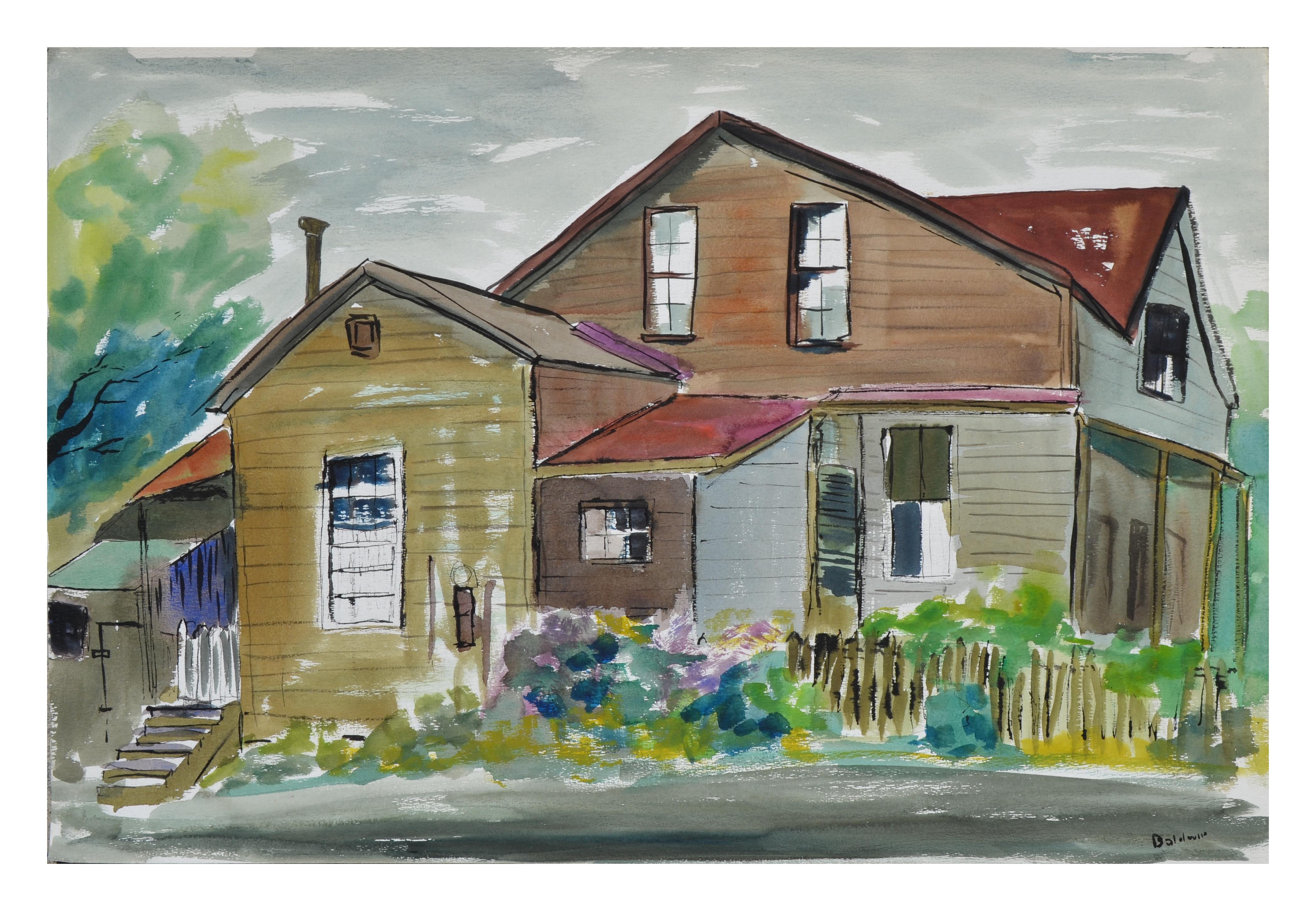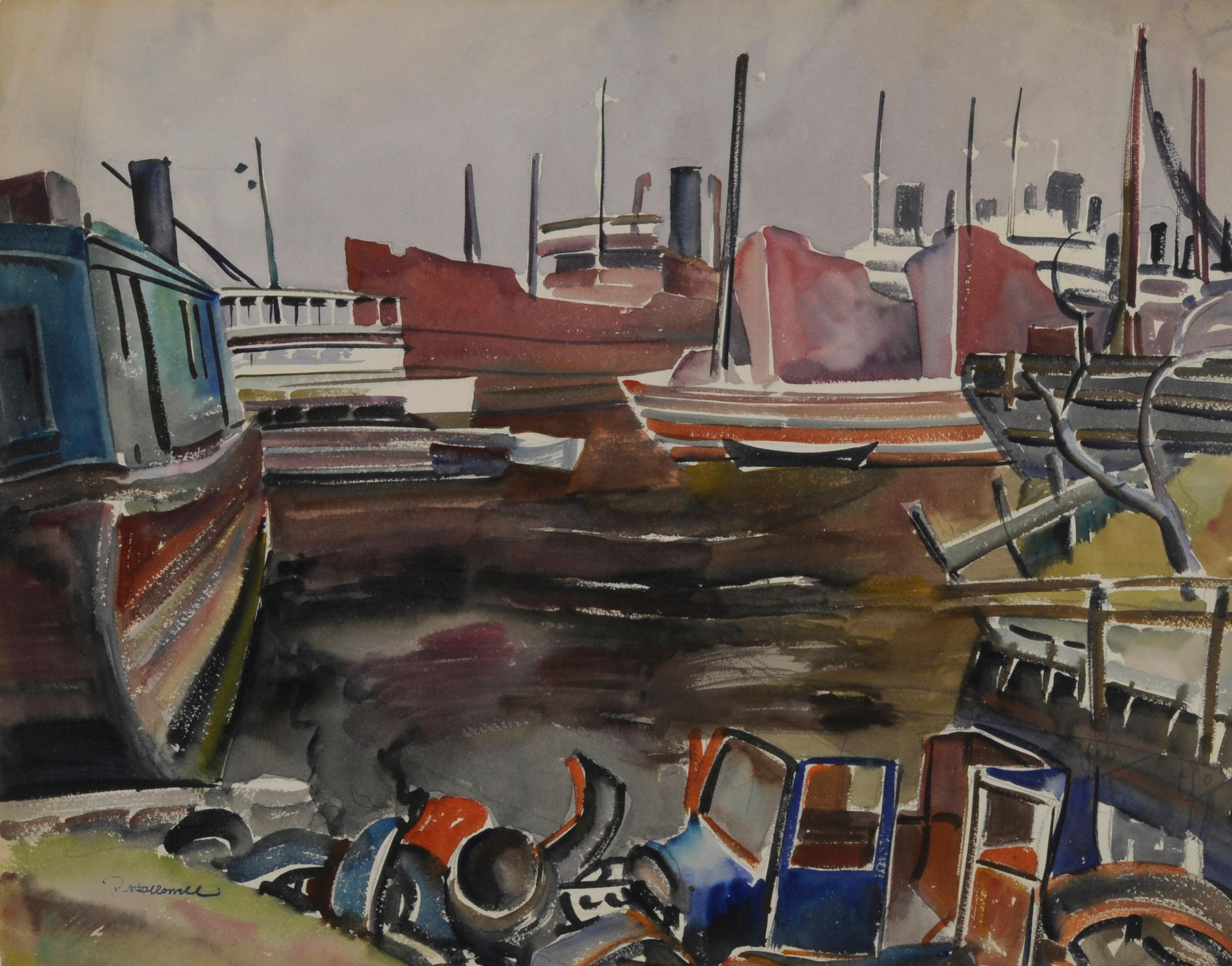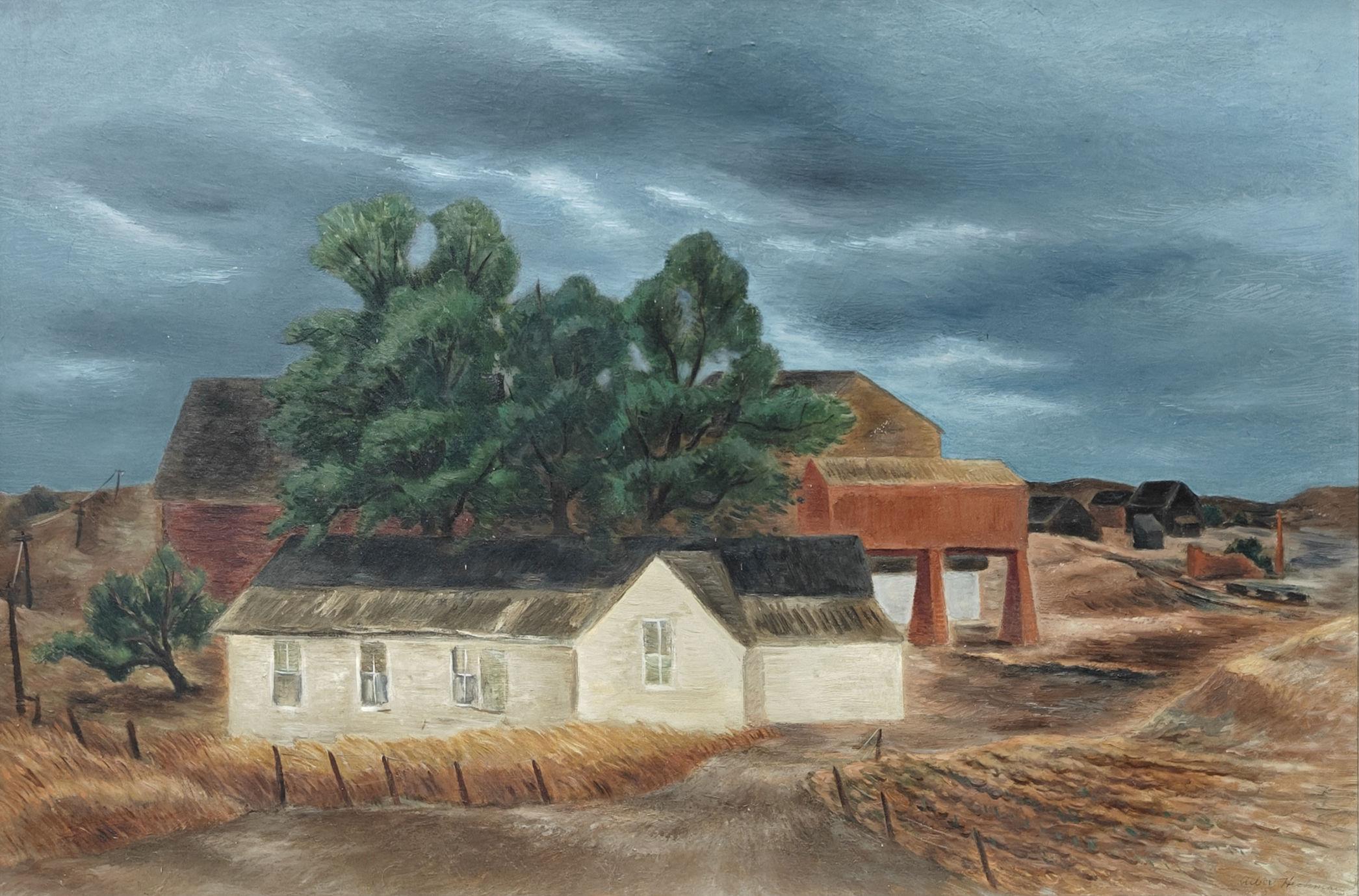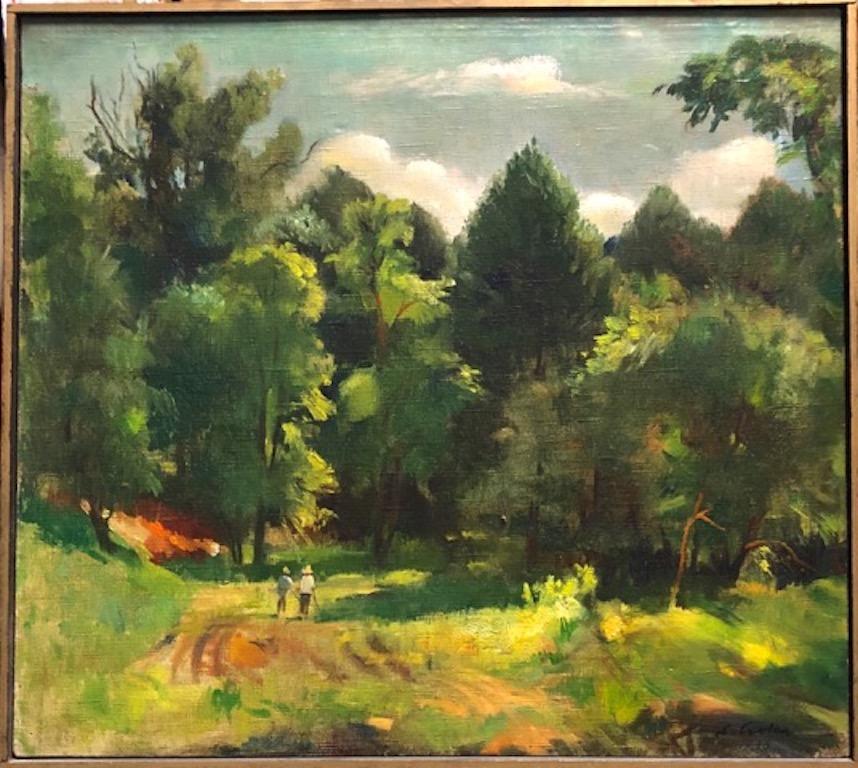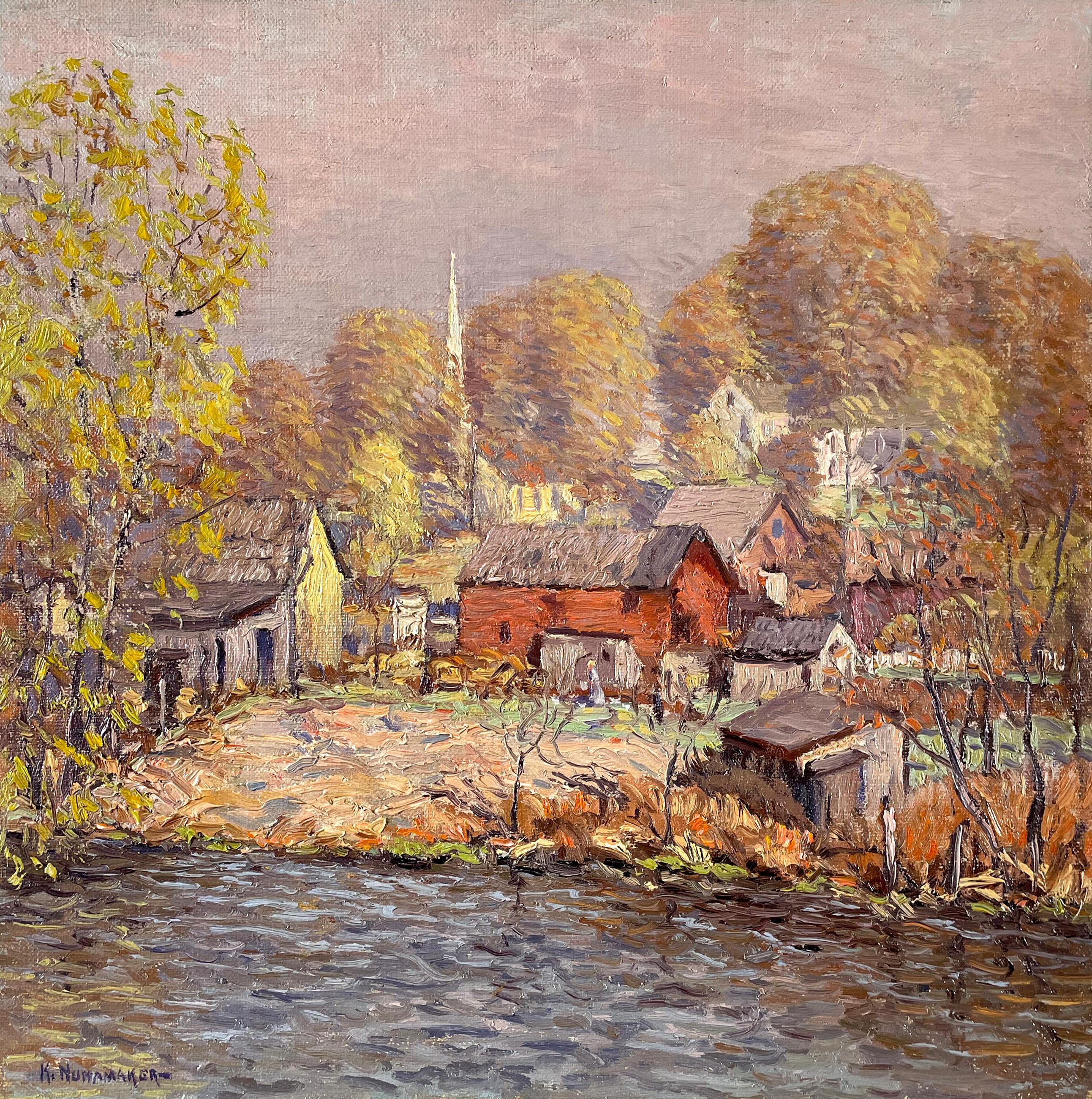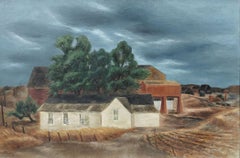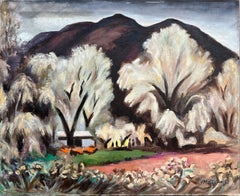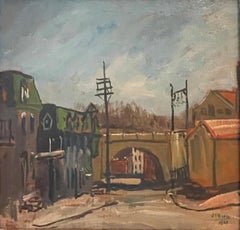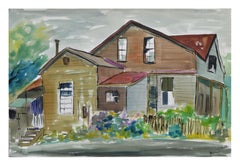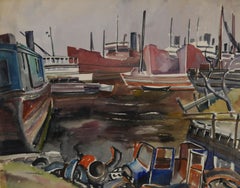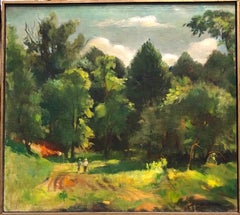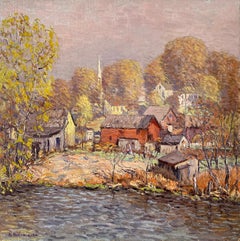Items Similar to "Backyard, Staten Island, New York" Bumpei Usui, Japanase-American Landscape
Want more images or videos?
Request additional images or videos from the seller
1 of 8
Bumpei Usui"Backyard, Staten Island, New York" Bumpei Usui, Japanase-American Landscape1933
1933
$18,000
£13,646.47
€15,730.77
CA$25,350.11
A$28,111.40
CHF 14,770.45
MX$343,473.52
NOK 184,798.54
SEK 173,465
DKK 117,433.31
About the Item
Bumpei Usui
Backyard, Staten Island, 1933
Signed lower right
Oil on canvas
20 x 24 inches
Provenance:
The artist's estate
Salander O'Reilly Galleries, New York
Arlene Berman, New York
Bumpei Usui was born in Nagano, Japan, in 1889. He told a story of entering the United States by literally jumping off a ship and swimming, which no one ever had any reason to believe wasn't true. In the 1940's he owned and operated a frame shop on 13th Street just east of Fifth Avenue. The headquarters of the Communist Party of America (1919-1946) was next door. During World War II, Usui was not interned but was regularly questioned by FBI agents. Some sources say the frame shop was at 5 East 14th Street, but this is not the recollection of his nephew, George Howard.
Usui, as he was known to family and friends, was not a prolific artist because he worked full time in his frame shop. Through his framing, he came to know many famous artists in New York in the 1940’s and 1950’s. He framed the work of Milton Avery among other peers.
He was a personal friend of Yasuo Kuniyoshi, a well known Japanese-American artist. A portrait that he painted of him in Kuniyoshi's studio is in the Smithsonian American Art Museum in Washington, D.C.
Usui had an extensive collection of Samurai swords. In March of 1978, the apartment he lived in Greenwich with his wife was burglarized, and he and his wife, Frances Pratt, were tied up and held at gunpoint while most of the collection was stolen. He sold the balance of the collection at auction through Sotheby’s in January of 1979.
In 2014, the Metropolitan Museum of Art acquired The Furniture Factory from a New York gallery that had the painting for sale at a price at $150,000. The painting was acquired not for cash but in trade for other works of art from the Metropolitan’s collection. The painting in now on exhibit in the Contemporary Art Galleries of the Met.
He divorced his first wife, Lucille Bumpei, in 1943. He married Frances Elizabeth Pratt in 1955 and resided with her at 31-33 West 12th Street in Greenwich Village until he died. He is buried with Frances Pratt Usui in Nicholson Cemetery in Nicholson, Pennsylvania. A tombstone designed by his wife, Frances, and made by Bob Dombrowski, called "Spirit Gate" marks their grave.
- Creator:Bumpei Usui (1898 - 1994)
- Creation Year:1933
- Dimensions:Height: 21 in (53.34 cm)Width: 25 in (63.5 cm)
- Medium:
- Movement & Style:
- Period:
- Condition:
- Gallery Location:New York, NY
- Reference Number:1stDibs: LU1841211694502
About the Seller
5.0
Platinum Seller
Premium sellers with a 4.7+ rating and 24-hour response times
Established in 2022
1stDibs seller since 2022
120 sales on 1stDibs
Typical response time: <1 hour
- ShippingRetrieving quote...Shipping from: New York, NY
- Return Policy
Authenticity Guarantee
In the unlikely event there’s an issue with an item’s authenticity, contact us within 1 year for a full refund. DetailsMoney-Back Guarantee
If your item is not as described, is damaged in transit, or does not arrive, contact us within 7 days for a full refund. Details24-Hour Cancellation
You have a 24-hour grace period in which to reconsider your purchase, with no questions asked.Vetted Professional Sellers
Our world-class sellers must adhere to strict standards for service and quality, maintaining the integrity of our listings.Price-Match Guarantee
If you find that a seller listed the same item for a lower price elsewhere, we’ll match it.Trusted Global Delivery
Our best-in-class carrier network provides specialized shipping options worldwide, including custom delivery.More From This Seller
View All"Shanties in the Bronx, New York" Bumpei Usui, Japanase-American City Landscape
Located in New York, NY
Bumpei Usui
Shanties in the Bronx, 1933
Signed lower right
Oil on canvas
14 x 20 inches
Provenance:
The artist's estate
Salander O'Reilly Galleries, New Y...
Category
1930s American Realist Landscape Paintings
Materials
Canvas, Oil
"Glasco Landscape" Albert Heckman, circa 1940 New York Modernist Landscape
By Albert Heckman
Located in New York, NY
Albert Heckman
Glasco Landscape, circa 1940
Signed lower right
Oil on canvas
25 1/4 x 39 1/2 inches
Albert Heckman was born in Meadville, Western Pennsylvania, 1893. He went to New York City to try his hand at the art world in 1915 after graduating from high school and landing a job at the Meadville Post Office. In 1917, at the age of 24, Heckman enrolled part-time in Teachers' College, Columbia University's Fine Arts Department to begin his formal art education. He worked as a freelance ceramic and textile designer and occasionally as a lecturer at the Metropolitan Museum of Art. In the early 1920s, at the age of almost 30, he graduated with a Bachelor of Arts degree from Columbia Teachers College. He was especially impacted by his instructor at Columbia, Arthur Wesley Dow.
After graduating, he was hired by the Teachers' College as a Fine Arts instructor. He stayed with Columbia Teachers' College until 1929, when he left to attend the Leipzig Institute of Graphic Arts in Leipzig, Germany. Isami Doi (1903-1965), who was born in Hawaii, was arguably his most impressive student at Columbia. Doi is now regarded as one of the most prominent artists hailing from Hawaii. Heckman became an active member and officer of the Keramic Society and Design Guild of New York in the 1920s as part of his early commercial art career. The Society's mission was to share knowledge and showcase textile and ceramic design exhibits.
In 1922, Heckman married Florence Hardman, a concert violinist. Mrs. Heckman's concert schedule during the 1920s kept Albert and Florence Heckman apart for a significant portion of the time, but they spent what little time they had together designing and building their Woodstock, New York, summer house and grounds. A small house and an acre of surrounding land on Overlook Mountain, just behind the village of Woodstock, were purchased by Albert and Florence Heckman at the time of their marriage. Their Woodstock home, with its connections, friendships, and memories, became a central part of their lives over the years, even though they had an apartment in New York City.
Heckman's main artistic focus shifted to the house on Overlook Mountain and the nearby towns and villages, Kingston, Eddyville, and Glasco. After returning from the Leipzig Institute of Graphic Arts in 1930, Mr. Heckman joined Hunter College as an assistant professor of art. He worked there for almost thirty years, retiring in 1956. Throughout his tenure at Hunter, Mr. Heckman and his spouse spent the summers at their Woodstock residence and the winters in New York City. They were regular and well-known guests at the opera and art galleries in New York. Following his retirement in 1956, the Heckmans settled in Woodstock permanently, with occasional trips to Florida or Europe during the fall and winter. Mr. Heckman's close friends and artistic career were always connected to Woodstock or New York City. He joined the Woodstock art group early on and was greatly influenced by artists like Paul and Caroline Rohland, Emil Ganso, Yasuo Kuniyoshi, Andre Ruellan, and her husband, Jack...
Category
1940s American Modern Figurative Paintings
Materials
Canvas, Oil
"Bearsville, New York" Georgina Klitgaard, Modernist New York Wooded Landscape
By Georgina Klitgaard
Located in New York, NY
Georgina Klitgaard
Bearsville, New York
Signed lower right
Oil on canvas
26 1/4 x 32 inches
Georgina Klitgaard’s art has sometimes gotten lost in the critical propensity to assign ...
Category
Early 20th Century American Modern Figurative Paintings
Materials
Canvas, Oil
"Manayunk" Walter Emerson Baum, Pennsylvania Impressionist Landscape of Manayunk
By Walter Emerson Baum
Located in New York, NY
Walter Emerson Baum
Manayunk, 1953
Signed and dated lower right; titled and dated on the reverse
Oil on board
12 x 14 inches
Walter Baum was born December 14, 1884 in Sellersville,...
Category
1950s American Impressionist Figurative Paintings
Materials
Oil, Board
"Cluster of Houses near Woodstock" Albert Heckman, American Modernist Landscape
By Albert Heckman
Located in New York, NY
Albert Heckman
Cluster of Houses near Woodstock
Signed lower right
Oil on canvas
10 x 14 inches
Albert Heckman was born in Meadville, Western Pennsylvania, 1893. He went to New Yor...
Category
1940s American Modern Figurative Paintings
Materials
Canvas, Oil
"On the Upper Mississippi" Delle Miller, Missouri Regionalist Landscape
Located in New York, NY
Delle Miller
On the Upper Mississippi, circa 1926
Signed lower left
Oil on canvas
26 1/8 x 29 1/8 inches
By 1909, Miller was an instructor at the Kansas...
Category
1920s American Modern Landscape Paintings
Materials
Canvas, Oil
You May Also Like
Home and Garden Landscape
By Diane Baldwin
Located in Soquel, CA
A vintage home and garden in bloom is beautifully captured in this watercolor by Monterey Bay Artist artist Diane Baldwin (American, 20th century). Signe...
Category
1970s American Impressionist Landscape Paintings
Materials
Watercolor, Archival Paper
$249 Sale Price
50% Off
Staten Island
By Robert Hallowell
Located in Fairlawn, OH
Staten Island
Watercolor on paper, c. 1928
Signed with the Estate stamp lower left
Sheet size: 19 1/8 x 23 7/8 inches
Titled on verso
Part of small series of watercolors done of the ...
Category
1920s American Modern Landscape Drawings and Watercolors
Materials
Watercolor
Landscape American Hungarian European Modernism 1938 Realism Long Island WPA era
By Stephen Csoka
Located in New York, NY
Landscape American Hungarian European Modernism 1938 Realism Long Island WPA era. The canvas measures 18” x 20". The artist signed the stretcher as well as the canvas.
The scene depicts a spots in New York where Queens borders with Nassau county, Rosedale, which abuts the Five Towns. The border runs through Hook Creek, another painting we are currently offering.
Stephen (Istvan) Csoka was born in Gárdony, Hungary on January 2, 1897 and died in New York in 1989. He is best remembered as a painter and etcher of portraits, nudes, landscapes, genre, and horses. Csoka studied at the Budapest Royal Academy of Art and his memberships include Associate of the National Academy of Design in New York City; the Society of American Etchers in Brooklyn, NY; the Society of Brooklyn Artists; and the Hungarian Etchers Association.
Csoka's exhibitions and awards include a medal at the Barcelona International Exhibition in 1929; a prize at the City of Budapest Exhibit in 1930; prizes at the Society of American Etchers in 1942 and 1945; prizes at the Library of Congress in 1944 and 1946; a prize at the Society of Brooklyn Artists in 1944; a prize at the Philadelphia Watercolor Club in 1945; the Corcoran Gallery of Art in 1945; the Carnegie Institute in 1943, 1944, and 1945; the Art Institute of Chicago in 1944; the Los Angeles Museum of Art in 1945; the National Academy of Design from 1940 through 1945; one-artist shows at the Contemporary Artists in 1940, 1943, and 1945; and the Minneapolis State Fair in 1943. *Stephen continued to recieve awards and exhibit his work throughout his life. In 1997, Hofstra Museum sponsored a Retrospective/Centennial exhibition in honor of his birth.
Collections representing Csoka's work are the Metropolitan Museum of Art, New York, NY; the Brooklyn Museum, Brooklyn, NY; the Museum of Fine Arts, Boston, MA; the British Museum, London, England; the Bezalel National Museum, Jerusalem, Israel; the Butler Institute of American Art, Youngstown, Ohio; Whistler House Museum of Art, Lowell, MA; the Cleveland Museum of Art, Cleveland, OH; Columbus Museum of Art, Columbus, OH; the Sheldon Swope Art Museum, Terre Haute, IN; the Mobile Museum of Art, Mobile, AL; the Frederick R. Weisman Art Museum, Minneapolis, MN; the Museum of New Mexico, Santa Fe, NM; the Budapest Museum of Fine Arts, Budapest, Hungary; Hungarian National Gallery, Budapest, Hungary, the Museum of the City of Budapest, Budapest, Hungary; the Library of Congress, Washington, DC; Carnegie Museums of Pittsburgh, Pittsburgh, PA; the Chrysler Museum of Art, Norfolk, VA; Georgia Museum of Art, Athens, GA; Hofstra Museum, Hofstra University, Hempstead, NY; Holocaust Museum, Glen Cove, NY; National Academy of Art, New York, NY; New Orleans Museum of Art, New Orleans, LA; New York Historical Society, New York, NY;New York Public Library, New York, NY; National Gallery of Art, Washington, DC; Peabody Museum, Cambridge, MA; Pennsylvania Academy of the Fine Arts, Philadelphia, PA; Reading Public Museum, Reading, PA; Livingston Arts Center, Mount Morris, NY; Ball State Teachers College, Muncie, IN; City College, New York, NY; Fashion Institute of Technology, New York, NY; Hungarian Consulate, New York, NY; Hungarian Heritage, New Brunswick, NJ; Hunter College, New York, NY; IBM Collections; Princeton Print Club...
Category
1930s Realist Landscape Paintings
Materials
Canvas, Oil
Early View of Stockton, New Jersey
Located in Bryn Mawr, PA
Kenneth Nunamaker never took a formal art lesson. His “training” began during his travels out West as a young man, where he painted in his spare time. It continued informally through...
Category
1930s Impressionist Landscape Paintings
Materials
Oil, Board
New England Coastal Town Landscape w/ Houses, Cleveland School Woman Artist
Located in Beachwood, OH
Kae Dorn Cass (American, 1901-1971)
New England Coastal Town
Watercolor on paper
Signed lower right
9 in. h. x 11.5 in. w.
17 in. h. x 19 in. w., as framed
Kae Dorn Cass was born...
Category
Mid-20th Century Figurative Drawings and Watercolors
Materials
Watercolor
"New York Backyards Study"
By Gershon Benjamin
Located in Lambertville, NJ
Jim’s of Lambertville is proud to offer this artwork by:
Gershon Benjamin (1899-1985)
An American Modernist of portraits, landscapes, still lives, and the urban scene, Gershon Benj...
Category
1930s Modern Landscape Paintings
Materials
Oil, Board
More Ways To Browse
York Factory Ii
Vintage Cemetery Sign
Vintage Dior Tie
March Avery
George Washington Nicholson
Bumpei Usui
Vintage Autumn Painting
Original Oil Painting Canada
Paintings Victorian London
French Impressionist Painting Gold Frame
Monet Claude
Pastoral Landscape Oil Painting
Robert Wood Oil Painting
Vermont Landscape
Barbizon Painters
Belgian Impressionists
Sacramento California
After The Storm
